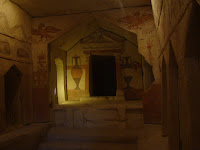




Our final day of this three day field trip was spent in the Negev of Judah. I think most of us were ready for the cooler temperatures of Jerusalem. Today we would visit the Fortress of Masada, Ed Gedi, the Dead Sea and Qumran. These are places that I was personally looking forward to seeing and experiencing.
Our first stop was the Fortress of Masada built by Herod the Great as a fortress/retreat. The fortress became famous not because or Herod but because of the Zealots who inhabited this dwelling from 66-73 AD. This fortress sits over 1300 feet above the surface of the Dead Sea with the Northern palace tier sitting at what would be Sea level. We approached the fortress from the West bringing us to the base of the western wall where the Roman Siege ramp is still evident today. We made our way into Masada by a path and steps that ran along the right side of the siege ramp.
The Zealots remodeled Masada when they began living here in AD 66 knowing they would be out of the reach from the Romans who would eventually destroy Jerusalem in AD 70 in the Great Rebellion. Archeologists have found a synagogue as well as several miqvah (ceremonial washing pools) built according to Jewish requirements on this site. One of the western rooms contained a scroll of Deuteronomy and as well as other sectarian scrolls. Massive storerooms were discovered where food supplies were kept. These storerooms were burned before the mass suicides took place.
Our journey from this mountain fortress was by way of the snake path on the eastern side facing the Dead Sea. The path took us 1300 feet back to floor of the Rift Valley. This journey down was filled with steps, twists and turns. Being afraid of heights brought more challenges for me as you can imagine.
Our next stop was across the street from En Gedi where we took our lunch break. While several were preparing lunch the others of us took a dip in the Dead Sea. I was amazed at how blue (no comments) the water looked. I had assumed that since the Dead Sea was dead that it couldn’t be as clear and blue as it was. The Dead Sea is 25-30% slat. The mineral makeup of the Dead Sea is extremely good for your skin. After about 5 minutes I knew that I could check ‘swimming in the Dead Sea’ off of my bucket list. I washed off and helped with lunch preparations.
Our time spent at Masada and the Dead Sea took longer than expected so we were unable to stop at the caves in En Gedi. En Gedi would be one of the places that David and his men hid while fleeing from King Saul. There is the spring located here that would have allowed David and his men to be able to sustain themselves. This would be the probable location where David wrote many of his Psalms. Next time back in Israel this will be a place I would like to visit rather than just drive by.
Our last stop was the Essene remains of Qumran. The Essenes were a religious community that had separated itself from the main stream of Judaism in order to seek the coming Messiah and a more righteous and personal observance of faith. The remains found here contain a kitchen, scroll rooms, numerous ritual cleansing pools, miqvah but yet no indication that people lived on the site giving archeologists the thought that the inhabitants of the community lived in tents or the surrounding caves.
The caves in the area produced what we know today as the Dead Sea Scrolls. Several of the caves are no longer in existence such as caves 7-10 due to the soil the caves were carved out of. Cave 4 is the cave that we see in most pictures of this area. We were able to travel about a mile down the road off the beaten path to explore cave 11. This cave produced a copy of all the Psalms and a few other significant finds. The cave looked like a cave but understanding the significance of finding these scrolls back in the late 1940’s made the stop an incredible experience. To be at the place where OT scholarship received validation of the OT Scripture dating back more than 1100 years from previous copies of the OT gives credence to God’s ability and demonstration of His sovereign preservation of the Scriptures.
Picture 1 - Our lead guides to Masada
Picture 2 - Masada west side up the siege ramp
Picture 3 - steps up the west side
Picture 4 - Dead Sea from Masada
Picture 5 - Cave 4 Qumran





















